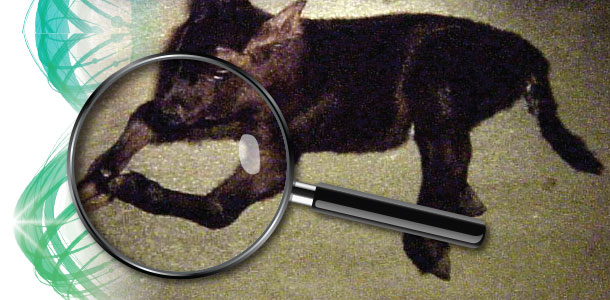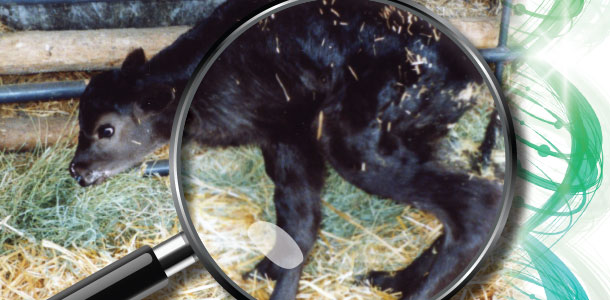A number of genomic tests have been developed, and most breed associations offer tests to check for certain traits or defects.
For instance, there are three types of tests available through Angus Genetics Inc. (AGI) for Angus breeders – for parentage, genetic conditions and performance traits.
Breeders can use genetic information to assess risk, genetic merit and make more informed breeding decisions.
With DNA samples, researchers discovered the genetic basis for certain defects and conditions found in cattle.
Genetic tests help breeders identify carrier animals, facilitating selective matings to avoid these defects in offspring.
Tests are available for arthrogryposis multiplex (AM – curly calf), neuropathic hydrocephalus (NH – water head), contractural arachnodactyly (CA – fawn calf) and several other conditions and defects.
One of the most recent tests is for development duplication (DD). Calves inheriting this recessive trait (receiving the defective gene from each parent) may in some cases be born with extra legs, generally front legs attached to the neck or shoulder. Affected calves can survive if the extra limbs are removed.
With DD, there may also be an increase in early embryonic death. Some herds in which the defect has appeared have seen a drop in pregnancy rates.
Research is being conducted to determine to what extent this is occurring.
Dr. Jonathan Beever, professor of molecular genetics at the University of Illinois, has done much of the research in developing tests for genetic defects and conditions.
“We’ve created more than a dozen tests in the past eight years at the request of breeders or breed associations. We’ve done work in sheep, dogs, cattle and other species,” he explains.
Some detrimental mutations have existed for many generations in popular bloodlines. Now we have a way to know which animals are carriers, so we can work around a defect and not produce a defective calf.
“Back in the 1950s and ’60s, when dwarfism or other genetic problems cropped up, breeders thought they had to get rid of all the animals in those pedigrees,” Beever says.
“We don’t have to do this any more because we can test their genetics – and keep the animals that are free of the problem or breed around a problem by never mating carrier animals to one another.
“Seedstock breeders should educate their customers if a new defect is discovered. If a breeder has a good relationship with his commercial bull buyers, he should call his customers and say, ‘In years past, you’ve bought bulls from us and those bulls had x genetics.
"We realize now that in some of those pedigrees there is a genetic mutation. When you come to my sale, you need to buy such and such so we can manage the situation.’
"Then the buyer won’t unknowingly double up that mutation in his herd and end up with a problem,” explains Beever.
Some seedstock producers are afraid that if they say anything to their customers, they might not buy bulls.
The responsible thing, however, is to help educate buyers and ensure they don’t end up with problems. This will create more trust between the seedstock producer and bull buyers.
We are lucky today to be able to test cattle. In earlier days, the only way to find out if a bull carried an unwanted trait such as dwarfism was to breed him to 32 of his own daughters to see if the defect showed up in the calves.
Genetic testing has dramatically sped up the process and enhanced our ability to make wise breeding decisions.

Producer comments
Jarold Callahan of Express Ranches in Yukon, Oklahoma, says genetic tests have been a helpful selection and marketing tool for breeders, as well as a frustration.
“We’ve had to test for AM, NH and CA, and now we also have to consider testing for DD – the latest genetic condition in Angus,” says Callahan.
“Because DD has variable expression rather than being a lethal defect, the American Angus Association is allowing carrier bulls to be used for A.I. and encouraging testing rather than requiring it.
"But to protect the end user – the commercial bull buyer, they are marking the papers (as a potential, carrier or free) and will let the marketplace assess the risk.
“To protect the end user – since most catalogs only show a two-generation or three-generation pedigree and the carrier could be back five or six generations and you wouldn’t know it – they are marking the papers,” he explains.
“The Angus breed is in an enviable position with 65 to 75 percent of the commercial bull market. The association has an obligation to protect that market for its members,” explains Callahan.
If buyers have problems with an Angus bull – siring calves with a genetic defect – they will buy something else. If a commercial herd is Angus-based, there is risk for doubling up genetic defects if they use a bull that carries the same recessive trait that might exist in some of their cows.

If a rancher doesn’t know the status of a bull, it would be safer to use a different breed.
“For our bull sale in October, we had all bulls tested, and their papers marked as free or a carrier, because we tested all the potentials.
"We have some buyers who don’t care if the bulls are carriers because they are using Angus bulls for crossbreeding.
"Some have herds with Brahman influence or Hereford cows and won’t double up this recessive gene,” says Callahan.
“Express Ranches feels we have an obligation to inform our buyers of the results of the tests for this genetic condition.
"Now you don’t have to get rid of the bloodline to resolve a problem; you just have to be careful how you breed these animals,” he says.
Once breeders understand this, the defect becomes manageable and can be bred out of a population over time.
Buddy Westphal of Valley View Charolais in Polson, Montana, says the Charolais breed is a few years behind some of the others in gene testing.
“Our breed recently approved more funding for tests because we don’t have much genetic information yet on Charolais cattle. The association is collecting data and trying to do what some of the other breeds have done,” he says.
“The Angus breed is doing a good thing – identifying, finding and eliminating a number of genetic defects.
"This is helpful for breed improvement and assuring customers that they aren’t buying a problem.
"A large Angus operation with ranches in Idaho, Montana and Utah cancelled their fall bull sale because they did not have time to test all their bulls with the new test before the sale,” says Westphal.
Bulls that would have been sold at that sale will be offered in their March 2014 sale. In a letter to their customers, the owner and manager mentioned the recently recognized defect (DD) and the fact that the American Angus Association guidelines suggest that Angus breeders decide for themselves whether to sell bulls carrying the DD defective gene.
This differs from the mandatory testing for other defects like AM and NH, refusing registration for carriers.
“Genetic testing of potential DD carriers is not mandatory, and animals identified as DD carriers are still eligible for registration.
"Therefore, some breeders have decided not to test for this gene. However … all of our bulls that have the possibility of being a carrier will be tested for DD.
"Cancelling our fall bull sale ensures that all bulls offered in our … spring bull sale will be tested and found free of the DD recessive allele.
"We feel strongly that only bulls found to be free of all known genetic defects should be sold at our sales,” the letter states.
Westphal feels that responsible breeders want to know as much as they can about the genetics of their cattle so they can assure customers they aren’t buying a problem.
“In a commercial cow herd, the producer isn’t testing his cows and can’t risk using any bull that might be a carrier.
"It pays to deal with reputable breeders if you are buying bulls or replacement heifers – to know and trust what you are getting. As seedstock breeders, we need to be on top of everything and identifying any problems,” he says. ![]()
Heather Smith Thomas is a freelance writer based in Idaho.
PHOTOS
TOP: Some of the more commonly known genetic defects are neuropathic hydrocephalus (NH) or water head.
MIDDLE: Arthropryposis multiples (AM) or curly calf.
BOTTOM: Contractural arachnodactyly (CA) or fawn calf. Photos by Heather Thomas.








